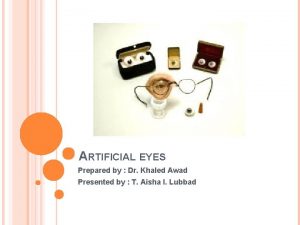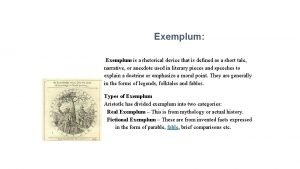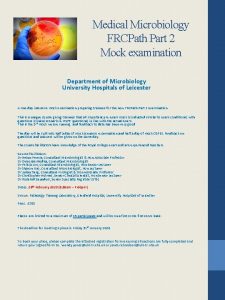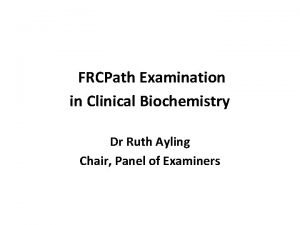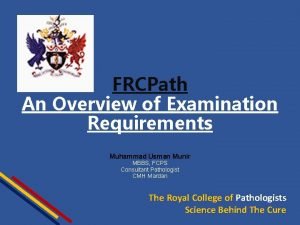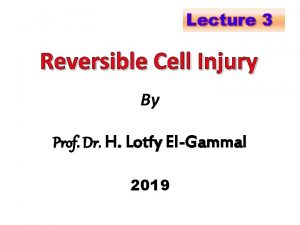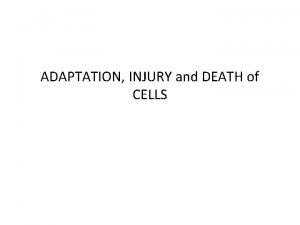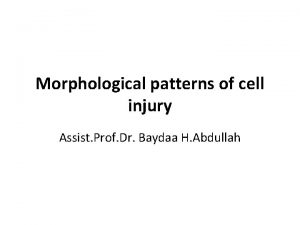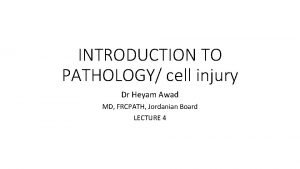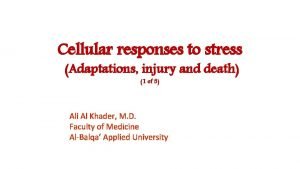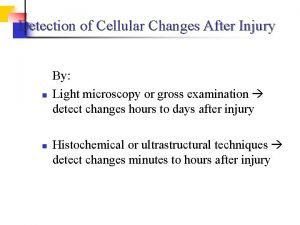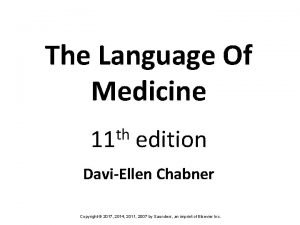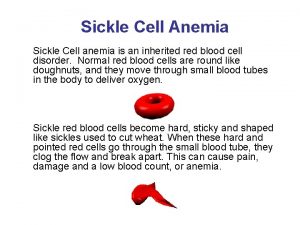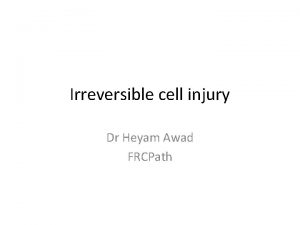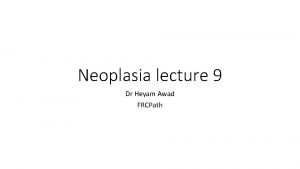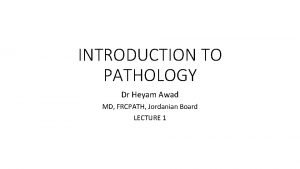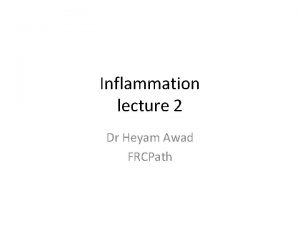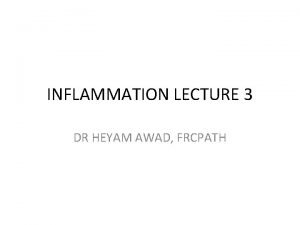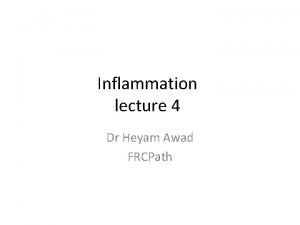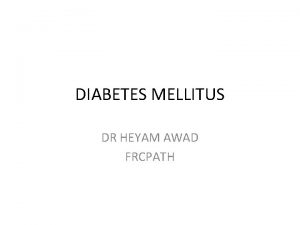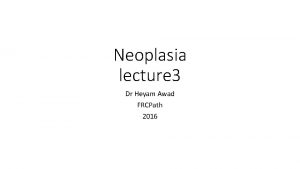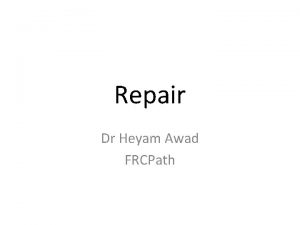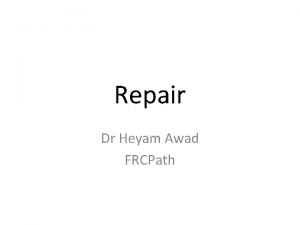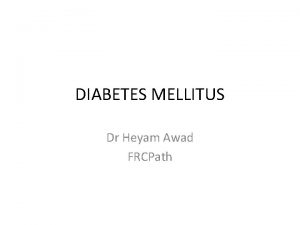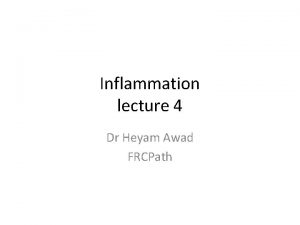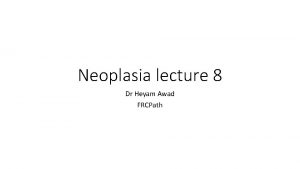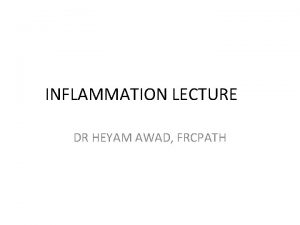Cell injury Dr Heyam Awad FRCPath Causes of




















- Slides: 20

Cell injury Dr Heyam Awad FRCPath

Causes of cell injury/ 1 • • Chemica agents Infections. Immunologic Genetic factors Nutritional imbalances Physical agents Aging.

Causes of cell injury/ 2 Oxygen deprivation. . Hypoxia and ischemia. Hypoxia= oxygen deficiency Ischemia = loss of blood supply due to impaired arterial flow or reduced venous return. -Ischemia is the most common cause of hypoxia. -Other causes of hypoxia: *reduced oxygen carrying capacity in anemia or carbon monoxide deficiency. *inadequate oxygenation of the blood as in pnumonia.

Rules and principles/ 1 • Cell response to injurious stimuli depend on type, duration and severity of the injury. • Example: low dose of a toxin cause reversible injury whereas larger dosed can cause cell death. • Short-lived ischemia. . Reversible • Ischemia of long duration… death

Rules and principles/ 2 • Response to injury also depends on type, status, adaptability and genetic makeup of the injured cell. • Example: skeletal muscle cells can stand 2 -3 hours of ischemia without irreversible injury but cardiac muscles die in 20 -30 minutes. • Glycogen content in hepatocytes can determine their response to injury. . How? • Genetic polymorphism in cytochrome P-450 influences response to toxins.

Rules and principles/ 3 Cell injury results from functional and biochemical changes in essential cellular components, mainly: • Mitochondrial function • Calcium homeostasis • Cell and organelle membranes • DNA • Protein synthesis and folding.

Rules and principles/ 4 • All injurious stimuli first affect the molecular or biochemical level. • Cellular functions lost before cell death occurs. • The morphologic changes of cell injury (or cell death) occur very late.

Rules/4 example • Ischemia of the heart… coronary artery occlusion. • Myocardial cells loose function ( become noncontractile) after 1 -2 minutes of ischemia. • They die 20 -30 minutes after ischemia. • It takes 2 -3 hours to recognise ultrastructural changes of death (EM) • 6 -12 hours by light microscope to appear dead.


Morphology of reversible cell injury • Cellular swelling : due to failure of energydependent ion pumps in the plasma membrane causing inability to maintain ion and fluid homeostasis. • Fatty change : small or large lipid vacuoles (hepatocytes and myocardial cells)

Cell swelling • The first manifestation of almost all forms of cell injury. • Reversible. • Grossly: organ affected becomes pale and gains weight. • Micro: small clear cytoplasmic vacuoles … which are distended endoplasmic reticulum.

Cell swelling

Cell swelling

Fatty change • In cells participating in fat metabolism: hepatocytes and myocardial cells) • Reversible • Fat droplets.

Fatty change

Ultrastructural changes of reversible injury (EM) • (1) plasma membrane changes such as blebbing, blunting or distortion of microvilli, and loosening of intercellular attachments. • (2) mitochondrial changes such as swelling and the appearance of phospholipid-rich amorphous densities. • (3) dilation of the ER with detachment of ribosomes and dissociation of polysomes. • (4) nuclear alterations, with clumping of chromatin.

EM changes

Mechanisms of cell injury • • • ATP depletion Mitochondrial damage Calcium influx Oxygen derived free radicals membrane defects Damage to DNA and protein

mechanisms

Mitochondrial damage
 Types of necrosis
Types of necrosis Awad mataria
Awad mataria Dr khaled awad
Dr khaled awad What is an exemplum
What is an exemplum Intentional injury and unintentional injury
Intentional injury and unintentional injury Frcpath part 1 microbiology
Frcpath part 1 microbiology Ayling sanjaya
Ayling sanjaya Mydetas
Mydetas Russell bodies
Russell bodies Hypoplasia
Hypoplasia Cell injury and inflammation
Cell injury and inflammation Cell injury and inflammation
Cell injury and inflammation Myelin figures in reversible cell injury
Myelin figures in reversible cell injury Example of physiological hyperplasia
Example of physiological hyperplasia Reversible cell injury
Reversible cell injury Ultimate vs proximate causation
Ultimate vs proximate causation Proximate causes vs ultimate causes
Proximate causes vs ultimate causes What causes cell
What causes cell Co hemoglobin
Co hemoglobin Cell city project animal cell
Cell city project animal cell Denuding tower
Denuding tower


